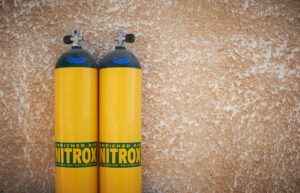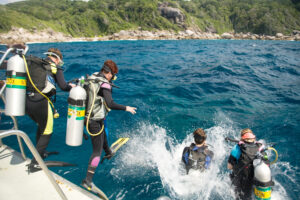What is a Bailout Bottle?
A bailout bottle, also known as a bailout cylinder, is a vital component in the world of scuba diving. It serves as a lifeline for divers by providing an emergency supply of air or other breathing gas in case of air supply trouble during a dive. This essential piece of scuba diving equipment is designed to ensure the safety and well-being of divers, particularly in situations where their primary air supply is compromised or unavailable. The following entry delves into the origin, purpose, design, and usage of bailout bottles, offering a comprehensive understanding of their critical role in scuba diving.
Origin and Purpose
The concept of a bailout bottle traces back to the early days of scuba diving when divers sought a reliable backup air supply to mitigate the risks associated with equipment failure or unforeseen emergencies. The term “bailout” refers to the act of resorting to an alternative plan in case of an unexpected situation or emergency. In the context of scuba diving, a bailout bottle serves as a diver’s secondary source of breathing gas, allowing them to safely return to the surface or reach a safe haven in the event of an air supply issue with their primary equipment.
Design and Components
Bailout bottles are small, portable cylinders that contain a compressed gas mixture suitable for breathing underwater. They are typically made of aluminum or steel and are designed to hold high-pressure gas mixtures, such as air, nitrox, or trimix, depending on the dive requirements and the diver’s training and certification level. These cylinders are equipped with a regulator, pressure gauge, and a mouthpiece, allowing the diver to breathe directly from the bailout bottle.
Bailout bottles vary in size, with capacities ranging from 6 to 40 cubic feet, depending on the diver’s needs and the nature of the dive. The size and capacity of the bailout bottle influence the duration of the emergency gas supply it provides. In general, larger cylinders offer a more extended gas supply but are heavier and more cumbersome to carry, while smaller cylinders are more portable but offer a shorter gas supply duration.
Usage and Considerations
Bailout bottles are commonly used in technical diving, cave diving, and deep diving, where divers face a higher risk of encountering emergencies or equipment failure. These diving disciplines often involve complex dive profiles, extended decompression obligations, or diving in overhead environments, increasing the importance of having a reliable emergency gas supply. When using a bailout bottle, divers need to consider several factors:
Gas Mixture
The appropriate gas mixture in the bailout bottle depends on the planned dive profile and the maximum depth of the dive. The diver must ensure that the gas mixture is breathable at all depths and is compatible with their dive plan and decompression requirements.
Capacity
The capacity of the bailout bottle should be adequate to provide enough emergency gas supply for the diver to safely ascend to the surface or reach a safe haven, considering factors such as the depth of the dive, decompression obligations, and potential emergencies.
Attachment and Accessibility
Bailout bottles should be securely attached to the diver’s gear, ideally using a mounting system that allows for quick and easy access in an emergency. Divers should regularly practice locating and deploying their bailout bottles to ensure they are familiar with the process and can do so efficiently in an emergency.
Regular Maintenance and Inspection
Bailout bottles, like all scuba diving equipment, require regular maintenance and inspection to ensure they are in proper working condition. This includes checking for corrosion, damage, or leaks, as well as verifying the cylinder’s hydrostatic and visual inspection dates.
Training and Certification
Divers planning to use a bailout bottle should receive appropriate training and certification from a recognized scuba diving agency. This training will cover essential skills such as bailout bottle deployment, gas management, and emergency procedures, ensuring the diver is well-prepared to handle any situation that may arise.
Gas Management and Planning
Divers must incorporate their bailout bottle into their gas management plan, accounting for the emergency gas supply when determining their overall gas consumption and dive time. This also involves monitoring the gas levels in both their primary and bailout cylinders during the dive and making necessary adjustments to their dive plan if required.
Redundancy
In some diving scenarios, particularly those involving significant depth or extended decompression obligations, divers may choose to carry multiple bailout bottles with different gas mixtures to further enhance their safety margin. This practice ensures that they have access to an appropriate gas mixture at various depths, reducing the risk of decompression sickness or gas toxicity.
In addition to these considerations, divers should also be mindful of local regulations and guidelines concerning the use of bailout bottles. Some diving locations may have specific rules or restrictions on their use, so it is crucial to familiarize oneself with these requirements before diving.
Key Takeaways
Bailout bottles are an indispensable safety measure for scuba divers, providing a crucial backup air supply in case of emergencies or equipment failure. As with all diving equipment, proper training, planning, and maintenance are essential to ensure the effective and safe use of bailout bottles. By understanding the various factors involved in their selection, use, and maintenance, divers can minimize the risks associated with diving and enhance their overall safety and enjoyment of the underwater world.








